Del Otero Hotel
Spring Park
The Hotel Del Otero was located at what is now 4050 Shoreline Drive in Spring Park, at Lake Minnetonka. The location was 18 miles from Minneapolis.
In the days before air conditioning, it was common for city folk to escape to the cool breezes of Lake Minnetonka for extended stays at large hotels like the Del Otero. The newspapers were full of announcements that prominent families were summering at the hotel, fishing and partaking of other summer fun.
See the bottom of this page for the Spring Park Casino
Some information on this page came from an article by Ton LaVoie published in by the Sun Patriot on August 3, 2012, called “Lake Minnetonka History: A look at the Del Otero Hotel”
HOTEL
The hotel itself underwent expansions over the years, and the capacity numbers changed considerably as reported in news articles. The postcard below shows the hotel, probably as originally built.
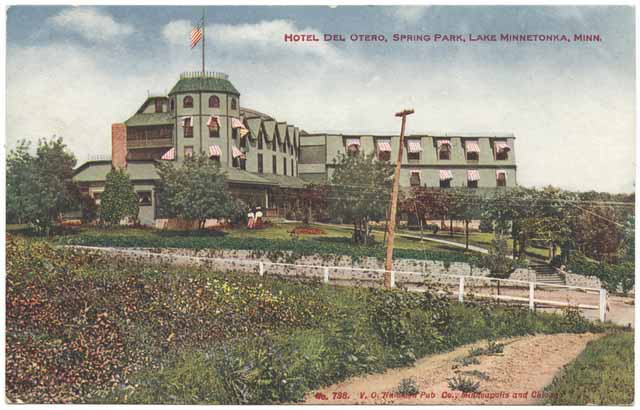
The photo below appears to show an addition on the left side. A large extension had been added to the hotel in 1901.
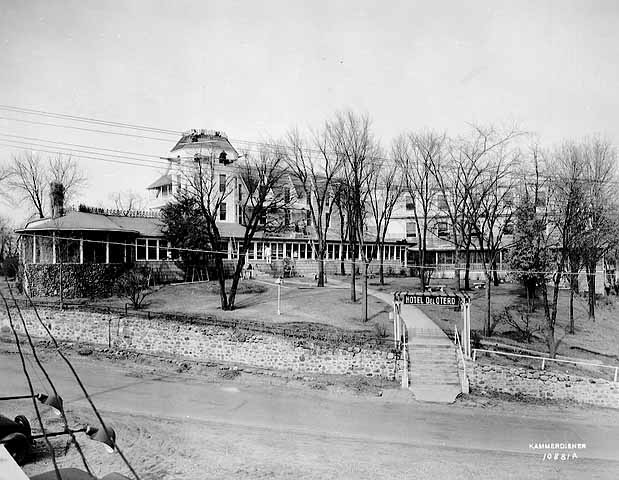
The cruise boats and streetcar boats visited the hotel docks.
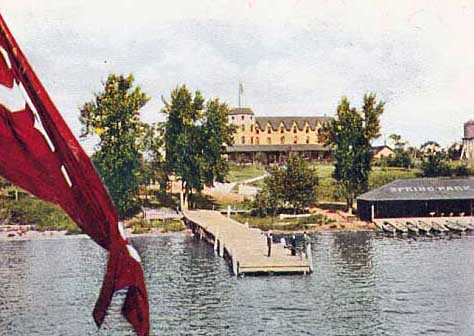
DINING
Guests and visitors came to the hotel by boat to dine in the hotel’s two large dining rooms. Many companies and associations had their annual banquets in these dining rooms.
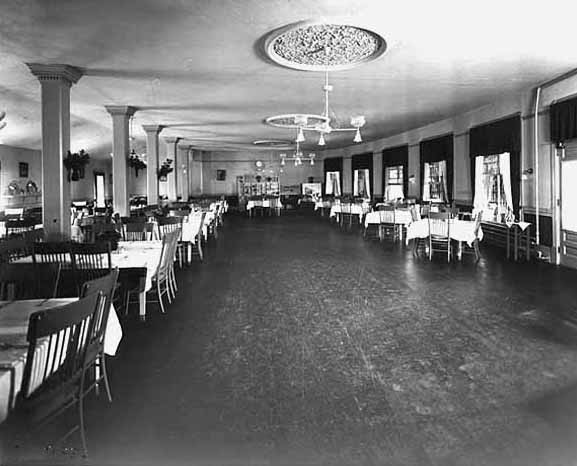
CHRONOLOGY OF THE DEL OTERO
The Del Otero was the second large hotel built by James J. Hill as a destination resort for his Great Northern railroad, designed to bring tourists and visitors to Lake Minnetonka. (The word “Otero” is Spanish for Hill.)
It was completed in May 1892, on the shore of the Spring Park Bay boat launch. [Although the date 1885 is often used, it is clearly stated in the first listing in the newspapers.com database that it is “a hew hotel, just completed.” (Minneapolis Tribune, May 29, 1892)] The hotel faced Spring Park Bay and had window rooms to take in the view from all around the area.
The first owner/manager was G.F. Hopkins. Since the hotel was only open during the summer, Hopkins and his wife wintered in California, where he also owned Rancho Del Otero, near San Diego.
In the 1904 season it was SRO, with guests sleeping on cots, in tents, and doubled up in rooms. The main draw was said to be Professor Sutorious providing musical treats for one and all. (Minneapolis Journal, August 15, 1904)
In June 1920, Adam F. King purchased the hotel. King had been the proprietor of a large hotel in Syracuse, New York, for 20 years. The announcement revealed that the hotel could accommodate 300 guests. The hotel was redecorated, and additional cottages were built. There was dancing daily, with the the Stewart’s Orchestra as the house band. (Minneapolis Tribune, June 6, 1920)
The hotel’s advertising was minimal at best, and usually placed on travel pages of the newspaper. The one below at least had some information about the place.
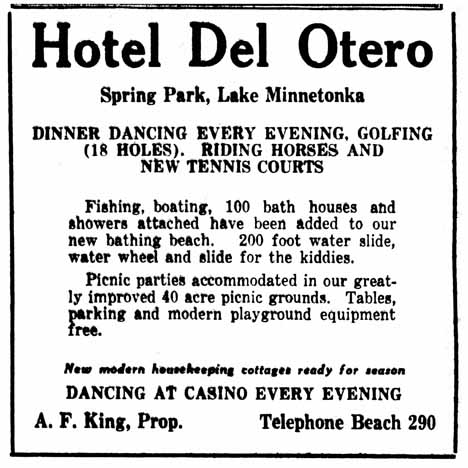
In April 1938, King purchased the rest of the rest of the 40-acre property, including the Casino (see below) and picnic grounds. The Tribune reported that it was the first change of ownership of this land since the establishment of the hotel by James J. Hill. The article said that the hotel’s capacity was 85 guest rooms, with nine cottages. (Tribune, May 1, 1938)
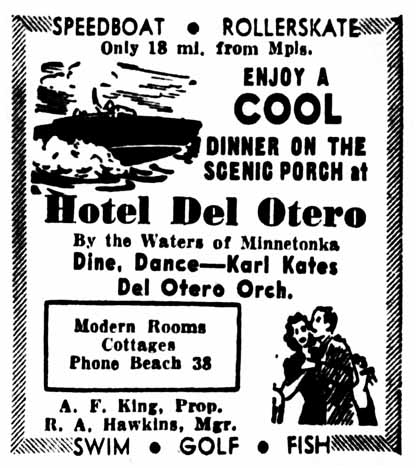
Classified ads show that help was difficult to find during the War years. Business must have been off, as room and board were offered to applicants. Rubber rationing made it difficult for city residents to drive to the Lake, although they could still take the bus or train.
THE END OF THE DEL OTERO
After 60 years, the Hotel Del Otero was gone in one night. On the evening of July 16, 1945, a gathering of military officers and guests were enjoying accommodations at the hotel. Around 3:25 a.m., fire broke out.
With the hotel’s position, the windy conditions of the lake, and the building’s three-story height, the fire was unstoppable. One section, a two-story towering structure built in rococo style surrounded by wide porches, burned completely to the ground. The remaining section burned to the first floor. The blaze was thought to have started in the kitchen. None of the guest cottages, mostly occupied by employees, were damaged. The account said that the hotel had 50 guest rooms.
43 people, most of them guests, fled the burning building with nothing but their nightclothes on their backs. Owner/Manager King carried his invalid brother to safety. A bellboy suffered a slight arm injury when he swung himself from a window in his tower bedroom to a porch roof. Many others made it to porch roofs as well and were rescued by firemen from Wayzata, Mound, and Excelsior. As the guests were rescued and firemen retrieved such belongings as they could, many of them got in their cars and drove home to Minneapolis. For others, the former Casino, now used as a war plant, was used as a place of refuge. Residents of Spring Park provided coffee and sandwiches.
King spoke of wanting to move the hotel to a vacant facility in order to honor existing contracts.
THE SPRING PARK CASINO
DANCING PAVILION
The original dancing pavilion was used for regularly scheduled dances (first known as “hops”), with music provided by bands. The floor, made of Georgia pine, was put in in 1901, and measured 50′ by 150′.
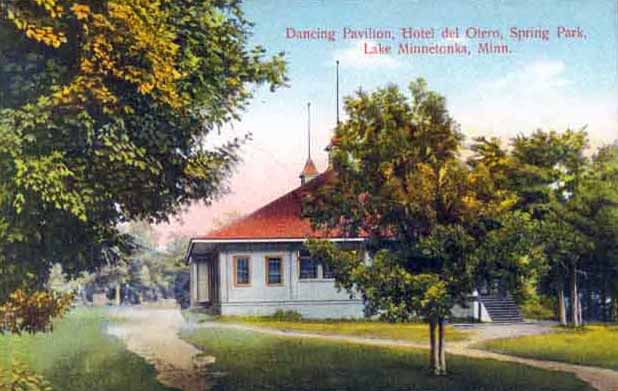
On August 24, 1902, the dancing pavilion was totally destroyed by fire. The building also housed a restaurant, boathouse, bowling alley, and a fleet of row boats underneath. The loss was estimated at $3,000, and the hotel carried no insurance. (Minneapolis Journal, August 25, 1902)
THE SPRING PARK CASINO
In the spring of 1903, it was reported that hotel owner G.F. Hopkins would build a new pavilion, called “The Casino,” to replace the one that burned. This one measured 48′ by 112′. The word Casino in those days did not mean a gambling casino, but a place for dancing and other recreation and entertainment.
Like the Dancing Pavilion, the Casino had a three-lane bowling alley, a cafe, and a boathouse in the basement stocked with rowboats for rental. The place was finished in “Flemish Oak.” It was considered an adjunct to the hotel, and was situated “across the highway” from the Del Otero. (Minneapolis Journal, June 13, 1903)
In 1905 and for several years, “hops” were given every Friday. It was announced that the Casino would be given a Mexican name, to match the other buildings at the Del Otero. Evidence of such a name could not be found. (Minneapolis Journal, July 20, 1905)
In 1931 the house band was the Admirals.
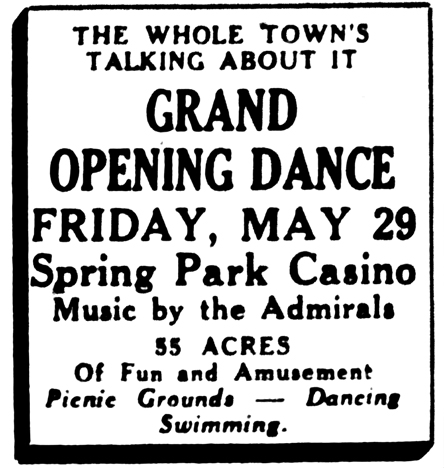
In 1933 it was the Hotel Del Otero Orchestra.
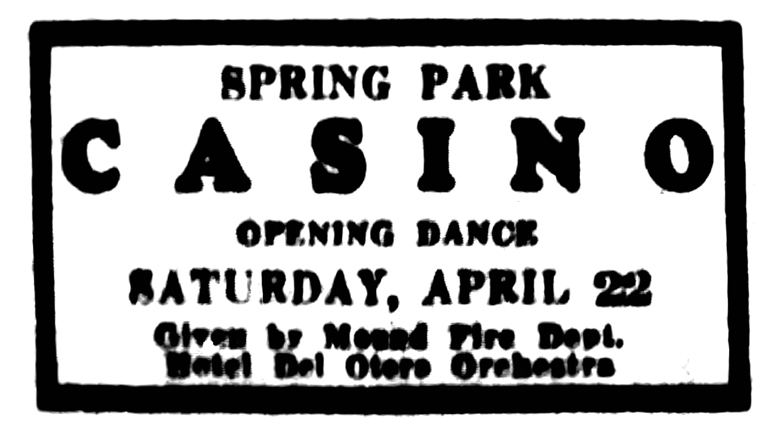
In April 1938, hotel owner A.F. King purchased the rest of the rest of the 40-acre property, including the Casino and picnic grounds. The Tribune reported that it was the first change of ownership of this land since the establishment of the hotel by James J. Hill. (Tribune, May 1, 1938)
In 1942, the Casino added a roller skating rink and amusement rides, including a Ferris wheel and merry-go-round. (Minneapolis Star, April 26, 1942)
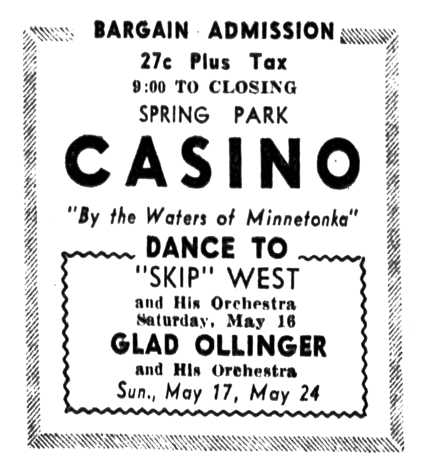
As the War dragged on, the Casino was leased to the L.E. Streator Lumber Co. for storage of ammunition boxes that it was manufacturing on contract for the government. The lumber company purchased the building in April 1944. (Minneapolis Star, April 25, 1944)
After the War the Casino had been turned into a new plastics plant by Streator. It was destroyed by fire on November 1, 1945. (Minneapolis Star-Journal, November 1, 1945)
In 1947 there was an article in the Star about plans to salvage part of the building, and that the beach area was now owned by the County. (Minneapolis Star, July 28, 1947)


